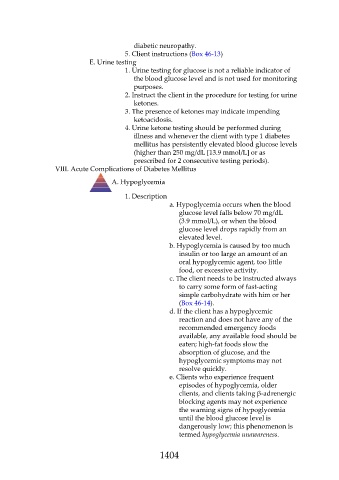Page 1404 - Saunders Comprehensive Review For NCLEX-RN
P. 1404
diabetic neuropathy.
5. Client instructions (Box 46-13)
E. Urine testing
1. Urine testing for glucose is not a reliable indicator of
the blood glucose level and is not used for monitoring
purposes.
2. Instruct the client in the procedure for testing for urine
ketones.
3. The presence of ketones may indicate impending
ketoacidosis.
4. Urine ketone testing should be performed during
illness and whenever the client with type 1 diabetes
mellitus has persistently elevated blood glucose levels
(higher than 250 mg/dL [13.9 mmol/L] or as
prescribed for 2 consecutive testing periods).
VIII. Acute Complications of Diabetes Mellitus
A. Hypoglycemia
1. Description
a. Hypoglycemia occurs when the blood
glucose level falls below 70 mg/dL
(3.9 mmol/L), or when the blood
glucose level drops rapidly from an
elevated level.
b. Hypoglycemia is caused by too much
insulin or too large an amount of an
oral hypoglycemic agent, too little
food, or excessive activity.
c. The client needs to be instructed always
to carry some form of fast-acting
simple carbohydrate with him or her
(Box 46-14).
d. If the client has a hypoglycemic
reaction and does not have any of the
recommended emergency foods
available, any available food should be
eaten; high-fat foods slow the
absorption of glucose, and the
hypoglycemic symptoms may not
resolve quickly.
e. Clients who experience frequent
episodes of hypoglycemia, older
clients, and clients taking β-adrenergic
blocking agents may not experience
the warning signs of hypoglycemia
until the blood glucose level is
dangerously low; this phenomenon is
termed hypoglycemia unawareness.
1404

